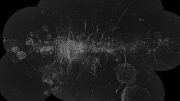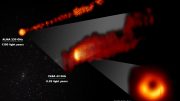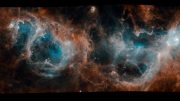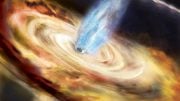
The Magnetic Field in the central parsec. Right: 12.5 µm acquisition image mosaic. The positions of several of the bright compact emission peaks discussed in the paper are indicated. Offsets are relative to the position of SgrA*, which is indicated by a star. Left: cartoon showing the larger scale structures in the central 5 pc and their relation to the features discussed in the text. P. F. Roche, et al, MNRAS, doi:10.1093/mnras/sty129
A research team has published a new study led by Pat Roche, professor of astrophysics at The University of Oxford, and Chris Packham, associate professor of physics and astronomy at The University of Texas at San Antonio. It reveals a new high-resolution map of the magnetic field lines in gas and dust swirling around the supermassive black hole at the center of our galaxy. The team created the map, which is the first of its kind, using the CanariCam infrared camera attached to the Gran Telescopio Canarias on the island of La Palma.
“This collaborative work is an exciting step forward in our collective efforts to gain a greater understanding of our own galaxy and the supermassive black hole at the center of it. It also demonstrates the importance of access to the largest telescopes using advanced cameras/techniques,” Packham said.
Black holes are objects with gravitational fields so strong that even light cannot escape their grasp. The center of almost every galaxy appears to host a black hole, including the Milky Way, where we live. Stars move around the black hole at speeds of up to 800 million kilometers an hour, indicating that it has a mass of at least a million times our Sun. Depending on how the material flows, some of it may eventually be captured and engulfed by the black hole.
Visible light from sources in the center of the Milky Way is blocked by clouds of gas and dust. Infrared light, as well as X-rays and radio, more freely passes through this obscuring material, so astronomers use this to see the region more clearly. CanariCam combines this with a polarizing device, which preferentially filters light with the particular characteristics associated with magnetic fields.

The polarization map of the central 0.75 parsec produced with a line integral convolution to emphasise the coherent structures. Oxford University/Royal Astronomical Society/UTSA
“This work, in addition to its scientific relevance, is very important to the advancement of the Ph.D. physics and astronomy program here at UTSA, since it involves students in cutting-edge research,” said Miguel Jose Yacaman, professor and Lutcher Brown Endowed Chair of the UTSA Department of Physics and Astronomy.
Centered on the supermassive black hole, the new infrared map covers a region of about one light-year on each side. The image shows the intensity of infrared light, and traces magnetic field lines within filaments of warm dust grains and hot gas, which appear here as thin lines reminiscent of brush strokes in a painting.
The filaments, several light-years long, appear to meet close to the black hole and may indicate where orbits of streams of gas and dust converge. One prominent feature links some of the brightest stars in the center of the galaxy. Despite the strong winds flowing from these stars, the filaments remain in place, bound by the magnetic field within them. Elsewhere the magnetic field is less clearly aligned with the filaments.
The new observations give astronomers more detailed information on the relationship between the bright stars and the dusty filaments. The origin of the magnetic field in this region is not understood, but it is likely that a smaller magnetic field is stretched out as the filaments are elongated by the gravitational influence of the black hole and stars in the galactic center.
“Big telescopes like GTC, and instruments like CanariCam, deliver real results,” Roche said. “We’re now able to watch material race around a black hole 25,000 light years away, and for the first time see magnetic fields there in detail.”
Reference: “The Magnetic Field in the central parsec of the Galaxy” by P F Roche, E Lopez-Rodriguez, C M Telesco, R Schödel and C Packham, 16 January 2018, MNRAS.
DOI: 10.1093/mnras/sty129









In search of black holes and dark matter astrophysicists are relying on indirect observations. It would seem that the measurement of the event horizon of a black hole directly would be a direct evidence. However, by the nature of a horizon, any real measurement of the event horizon will be indirect. The Event Horizon Telescope will get picture of the silhouette of the Sgr A* which is due to optical effects of spacetime outside of the event horizon. The result will be determined by the simple quality of the resulting image that does not depend on the properties of the spacetime within the image. So, it will be also indirect and an existence of BH is a hypothesis.
Wow. Amazing. Incredible.